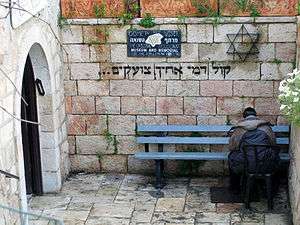Chamber of the Holocaust
Coordinates: 31°46′16.87″N 35°13′46.21″E / 31.7713528°N 35.2295028°E

Chamber of the Holocaust (Hebrew: מרתף השואה, Martef HaShoa, lit. "Cellar of the Holocaust") is a small Holocaust museum located on Mount Zion in Jerusalem. It was Israel's first Holocaust museum.[1][2]
History
The site was founded in 1948 by the Ministry of Religion and its Director-General, Rabbi Dr. Samuel Zangvil Kahane, whose purview included Mount Zion.[2] That same year, Kahane oversaw the on-site burial of ashes of victims from the Oranienburg concentration camp[3] together with desecrated Torah scrolls recovered from Nazi Europe.[4] In contrast to Yad Vashem, the government's official Holocaust memorial museum established in 1953 on Mount Herzl – a new site symbolizing rebirth after destruction – the Chief Rabbinate chose Mount Zion as the site for the Chamber of the Holocaust because of its proximity to David's Tomb, which symbolically connotes ancient Jewish history and the promise of messianic redemption (through the Messiah, son of David).[5][6] Scholars have noted that the somber ambience of the museum, whose dank, cave-like rooms[7] are illuminated by candelight,[8] is meant to portray the Holocaust as a continuation of the "death and destruction" that plagued Jewish communities throughout history.[9]
The museum is currently maintained by the Diaspora Yeshiva, with an Orthodox orientation.[2]
Description
The museum features a large courtyard and ten exhibition rooms.[2] The walls of the courtyard plus several rooms and passages are covered with tombstone-like plaques[10] inscribed in Hebrew, Yiddish, and English, memorializing more than 2,000 Jewish communities destroyed during the Holocaust.[11][12] These plaques were generally sponsored by survivors from those communities, and survivors hold memorial services here on the anniversary of their town's destruction.[11]
Below is an example, accompanied by a translation of the text:

In eternal memory
In memory of the souls of our dear friends, the martyrs of our city
in Israel and in the Diaspora.
Przedecz (Pshaytsh)
(Włocławek district)
who were murdered by the Nazis and their collaborators, may their names be obliterated
in Chełmno on the 7th day of Iyar, [5]742 [Anno Mundi], 24 April 1942
and in the other places of extermination, may God avenge their blood
The memorial day was established as the 7th day of Iyar
May their lives be bound in the bundle of the living
Their holy memory immortalized by the survivors of our city
Many of the museum's exhibits display religious artifacts such as a bloodstained Torah scroll from Węgrów, Poland, and a handwritten prayer book from the Buchenwald concentration camp. Other exhibits include "purses, shoe soles, drums and wallets made from the parchments of Torah scrolls",[2] a coat sewn from Torah parchments which was worn by a Nazi officer, a prisoner uniform from the Auschwitz concentration camp,[2] and a recreation of the gas oven used in the cremetoria of concentration camps.[13] The museum also includes urns with the ashes of Holocaust victims from 36 Nazi death camps[14] and "RIF" soap allegedly manufactured by the Nazis from human fat.[13] There is also an exhibit on neo-Nazism with a selection of modern-day antisemitic literature.[15]
References
- ↑ Arundale, Jean; Covington, Coline; Knox, Jean; Williams, Paul (2002). Terrorism and War: Unconscious dynamics of political violence. Karnac Books. p. 368. ISBN 1780496923.
- 1 2 3 4 5 6 "מרתף השואה" [Chamber of the Holocaust] (in Hebrew). Jerusalem Municipality. 2008.
- ↑ Baumel-Schwartz, Judith Tydor (2010). Perfect Heroes: The World War II parachutists and the making of Israeli collective memory. University of Wisconsin Press. p. 99. ISBN 0299234843.
- ↑ Kenan, Orna (2003). Between Memory and History: The evolution of Israeli historiography of the Holocaust, 1945–1961. Peter Lang. pp. 47–48. ISBN 0820458058.
- ↑ Edrei, Arye (2007-06-07). "Holocaust Memorial". In Doron Mendels. On Memory: An Interdisciplinary Approach. p. 43. ISBN 978-3-03911-064-3.
- ↑ Singer, Yehudit (May 6, 2008). "60 Years of Commemorating the Holocaust". ShiurTimes: 36–37.
- ↑ Jacobson, Mark (2010). The Lampshade: A Holocaust Detective story from Buchenwald to New Orleans. Simon & Schuster. pp. 274–275. ISBN 1416566279.
- ↑ Ullian, Robert (2010). Frommer's Israel. John Wiley & Sons. p. 182. ISBN 0470618205.
- ↑ Stauber, Roni (2007). The Holocaust in Israeli Public Debate in the 1950s: Ideology and memory. Vallentine Mitchell. p. 99. ISBN 085303723X.
- ↑ "Chamber of the Holocaust" (in Hebrew). Ministry of Tourism, Government of Israel. Retrieved May 11, 2012.
- 1 2 Amdur Sack, Sallyann (1995). A guide to Jewish genealogical research in Israel. Avotaynu. p. 67. ISBN 0962637378.
- ↑ Jacobs, Daniel; Eber, Shirley; Silvani, Francesca (1998). Israel and the Palestinian Territories: The Rough Guide. Rough Guides. p. 371. ISBN 1858282489.
- 1 2 "Chamber of the Holocaust Exhibitions". The Chamber of the Holocaust. Retrieved 14 May 2012.
- ↑ Israel government year-book. 1967. p. 331.
- ↑ Jacobs, Daniel (2000). Jerusalem: The Mini Rough Guide. Rough Guides. p. 138. ISBN 1858285798. Retrieved 25 April 2012.
External links
- Chamber of the Holocaust Museum and Memorial explanatory website
| Wikimedia Commons has media related to Chamber of the Holocaust Museum. |